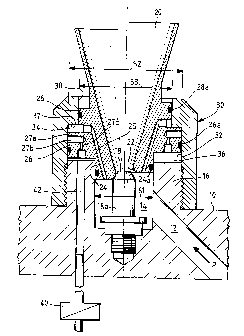Some of the information on this Web page has been provided by external sources. The Government of Canada is not responsible for the accuracy, reliability or currency of the information supplied by external sources. Users wishing to rely upon this information should consult directly with the source of the information. Content provided by external sources is not subject to official languages, privacy and accessibility requirements.
Any discrepancies in the text and image of the Claims and Abstract are due to differing posting times. Text of the Claims and Abstract are posted:
| (12) Patent: | (11) CA 2188393 |
|---|---|
| (54) English Title: | A DEVICE FOR CONTROLLING A SPACECRAFT BY GATING GAS VIA A MOVING NOZZLE |
| (54) French Title: | DISPOSITIF DE COMMANDE D'UN ENGIN SPATIAL PAR TRANSMISSION SELECTIVE DE GAZ VIA UN AJUTAGE MOBILE |
| Status: | Expired and beyond the Period of Reversal |
| (51) International Patent Classification (IPC): |
|
|---|---|
| (72) Inventors : |
|
| (73) Owners : |
|
| (71) Applicants : |
|
| (74) Agent: | MCCARTHY TETRAULT LLP |
| (74) Associate agent: | |
| (45) Issued: | 2002-02-19 |
| (22) Filed Date: | 1996-10-21 |
| (41) Open to Public Inspection: | 1997-04-21 |
| Examination requested: | 2000-09-08 |
| Availability of licence: | N/A |
| Dedicated to the Public: | N/A |
| (25) Language of filing: | English |
| Patent Cooperation Treaty (PCT): | No |
|---|
| (30) Application Priority Data: | ||||||
|---|---|---|---|---|---|---|
|
A device for controlling a spacecraft by gating gas,
the device comprising a nozzle (20), a gas feed duct
(12), a gate having a seat (22) and a plunger (18)
interposed between the feed duct and the nozzle, and
control means (40) for opening and closing the gate in
order to put the feed duct selectively into communication
with the nozzle. The seat (22) of the gate is secured to
the nozzle (20) and the nozzle is movable such that the
gate is opened and closed by displacement of the nozzle,
which displacement is driven directly by the hot gas,
without calling on an auxiliary fluid.
Note: Claims are shown in the official language in which they were submitted.
Note: Descriptions are shown in the official language in which they were submitted.

2024-08-01:As part of the Next Generation Patents (NGP) transition, the Canadian Patents Database (CPD) now contains a more detailed Event History, which replicates the Event Log of our new back-office solution.
Please note that "Inactive:" events refers to events no longer in use in our new back-office solution.
For a clearer understanding of the status of the application/patent presented on this page, the site Disclaimer , as well as the definitions for Patent , Event History , Maintenance Fee and Payment History should be consulted.
| Description | Date |
|---|---|
| Time Limit for Reversal Expired | 2008-10-21 |
| Letter Sent | 2007-10-22 |
| Inactive: IPC from MCD | 2006-03-12 |
| Inactive: Late MF processed | 2004-02-24 |
| Inactive: Late MF processed | 2004-02-24 |
| Letter Sent | 2003-10-21 |
| Grant by Issuance | 2002-02-19 |
| Inactive: Cover page published | 2002-02-18 |
| Pre-grant | 2001-11-23 |
| Inactive: Final fee received | 2001-11-23 |
| Notice of Allowance is Issued | 2001-06-01 |
| Notice of Allowance is Issued | 2001-06-01 |
| Letter Sent | 2001-06-01 |
| Inactive: Approved for allowance (AFA) | 2001-05-14 |
| Letter Sent | 2000-10-10 |
| Inactive: Status info is complete as of Log entry date | 2000-10-10 |
| Inactive: Application prosecuted on TS as of Log entry date | 2000-10-10 |
| Amendment Received - Voluntary Amendment | 2000-09-08 |
| Request for Examination Requirements Determined Compliant | 2000-09-08 |
| All Requirements for Examination Determined Compliant | 2000-09-08 |
| Letter Sent | 1999-07-08 |
| Inactive: Multiple transfers | 1999-03-23 |
| Letter Sent | 1997-11-18 |
| Application Published (Open to Public Inspection) | 1997-04-21 |
There is no abandonment history.
The last payment was received on 2001-09-21
Note : If the full payment has not been received on or before the date indicated, a further fee may be required which may be one of the following
Patent fees are adjusted on the 1st of January every year. The amounts above are the current amounts if received by December 31 of the current year.
Please refer to the CIPO
Patent Fees
web page to see all current fee amounts.
| Fee Type | Anniversary Year | Due Date | Paid Date |
|---|---|---|---|
| Registration of a document | 1996-10-21 | ||
| MF (application, 2nd anniv.) - standard | 02 | 1998-10-21 | 1998-09-23 |
| Registration of a document | 1999-03-23 | ||
| MF (application, 3rd anniv.) - standard | 03 | 1999-10-21 | 1999-10-06 |
| Request for examination - standard | 2000-09-08 | ||
| MF (application, 4th anniv.) - standard | 04 | 2000-10-23 | 2000-09-29 |
| MF (application, 5th anniv.) - standard | 05 | 2001-10-22 | 2001-09-21 |
| Final fee - standard | 2001-11-23 | ||
| MF (patent, 6th anniv.) - standard | 2002-10-21 | 2002-09-20 | |
| MF (patent, 7th anniv.) - standard | 2003-10-21 | 2004-02-24 | |
| Reversal of deemed expiry | 2003-10-21 | 2004-02-24 | |
| MF (patent, 8th anniv.) - standard | 2004-10-21 | 2004-09-27 | |
| MF (patent, 9th anniv.) - standard | 2005-10-21 | 2005-09-26 | |
| MF (patent, 10th anniv.) - standard | 2006-10-23 | 2006-09-26 |
Note: Records showing the ownership history in alphabetical order.
| Current Owners on Record |
|---|
| SOCIETE NATIONALE D'ETUDE ET DE CONSTRUCTION DE MOTEURS D'AVIATION "SNECMA" |
| SOCIETE EUROPEENNE DE PROPULSION |
| Past Owners on Record |
|---|
| ANDRE DUMORTIER |
| JEAN-GABRIEL FAGET |